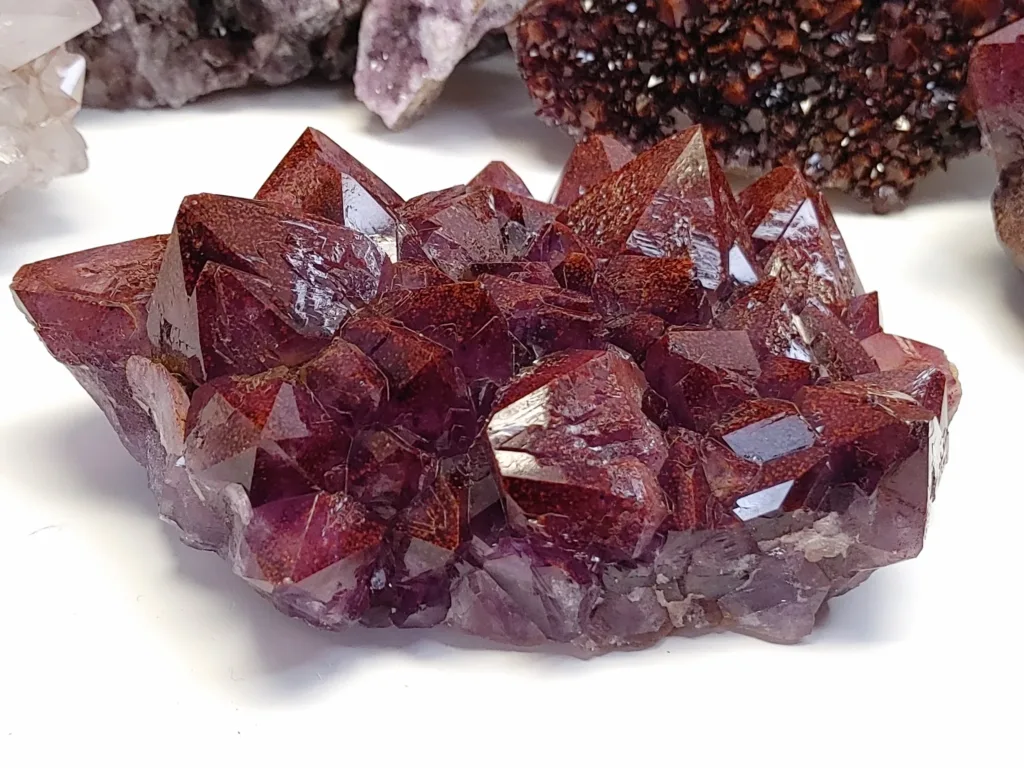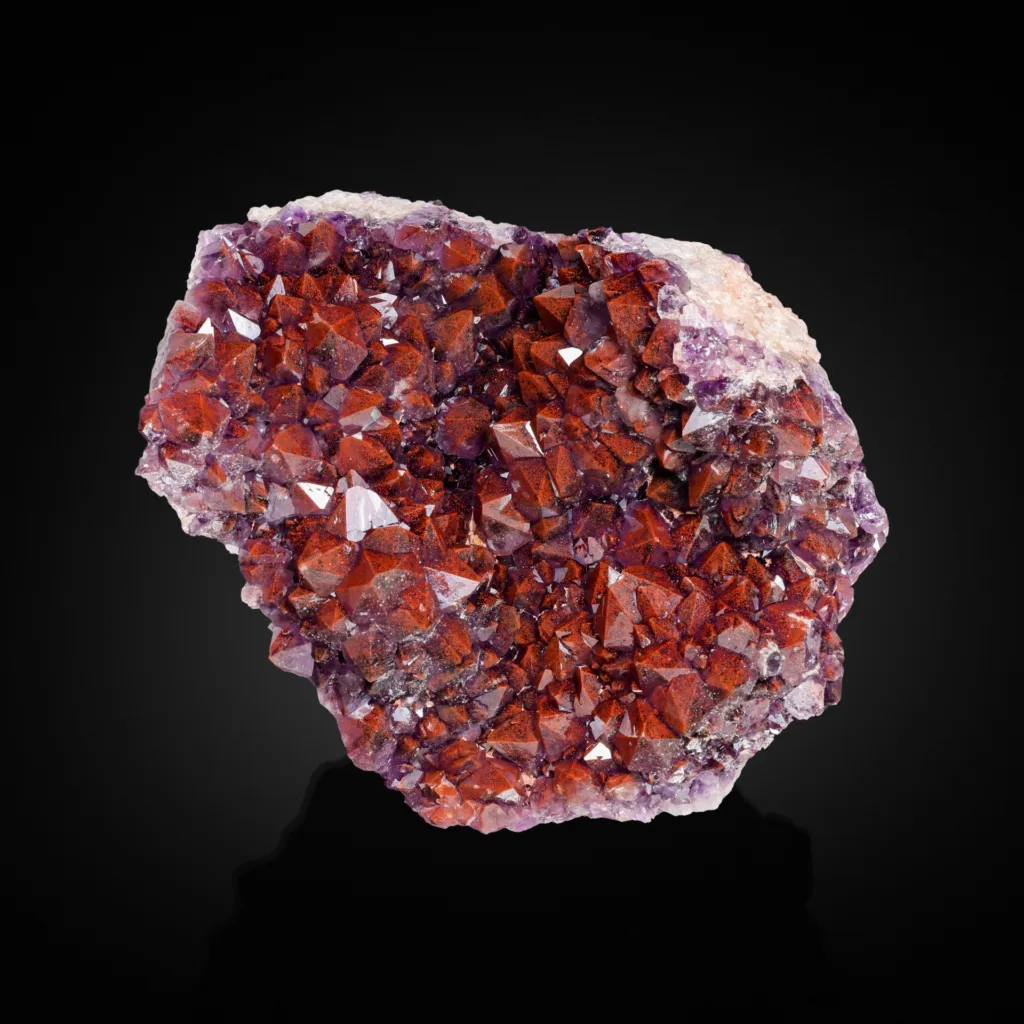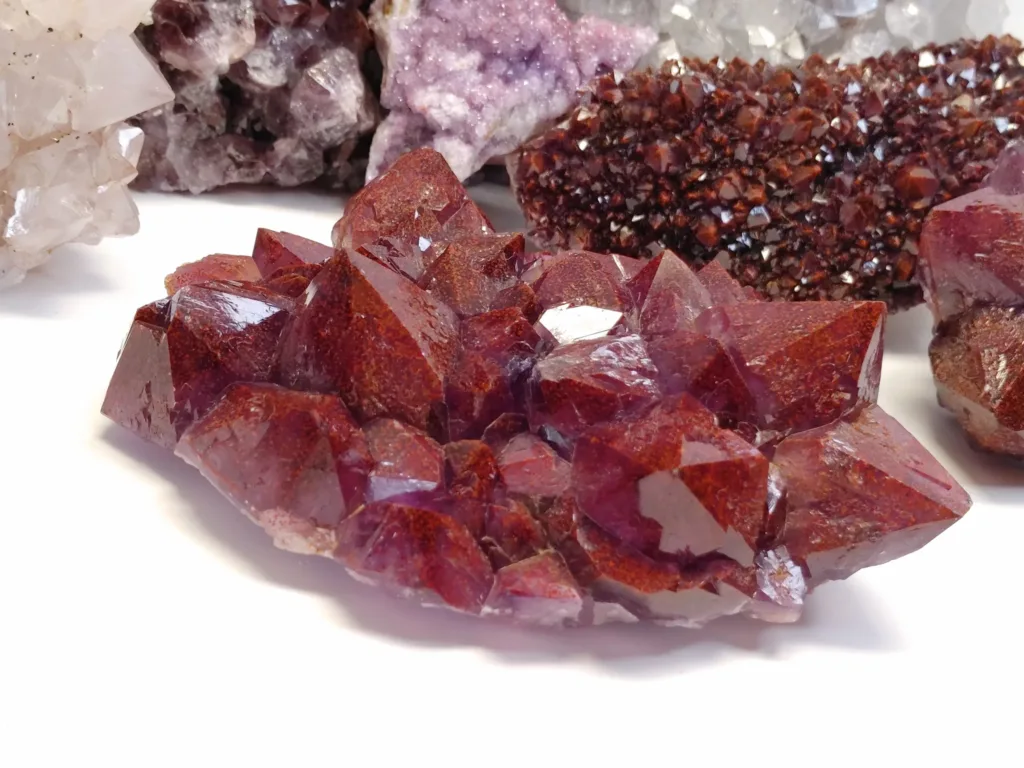Red amethyst is a unique variation of amethyst, a popular and cherished gemstone known for its stunning purple hue. What sets red amethyst apart is its intriguing combination of amethyst’s traditional purple coloration with hints of red or reddish-brown tones. This distinct coloration is believed to be caused by the presence of hematite, a mineral known for its reddish appearance, which forms inclusions within the amethyst crystals.

Red amethyst can exhibit a range of hues, from subtle reddish undertones to more prominent streaks or patches of red within the purple crystal structure. The intensity and distribution of the red coloration can vary widely, resulting in a diverse array of visually striking gemstones.
This gemstone is prized not only for its captivating appearance but also for its purported metaphysical properties. Like traditional amethyst, red amethyst is associated with qualities such as spiritual awareness, inner peace, and emotional balance. Additionally, the presence of hematite within the crystal is believed to imbue it with grounding energy, promoting stability and strength.
Red amethyst is often used in jewelry-making, where its unique coloration can add a vibrant and eye-catching touch to various designs. It is also sought after by collectors and enthusiasts for its rarity and beauty.
In summary, red amethyst is a captivating variation of the classic amethyst gemstone, distinguished by its infusion of reddish hues derived from the presence of hematite. With its striking appearance and purported metaphysical properties, red amethyst continues to enchant admirers and jewelry enthusiasts alike.
Geological Formation

Red amethyst is formed through a geological process similar to that of traditional amethyst, with the addition of hematite contributing to its unique coloration. Here’s a brief overview of the geological formation of red amethyst:
- Primary Formation: Like all varieties of amethyst, red amethyst originates from the Earth’s crust, where it forms within cavities or voids in igneous rocks such as granite or volcanic deposits. These cavities are often filled with hot, mineral-rich fluids known as hydrothermal solutions.
- Presence of Quartz: Amethyst itself is a variety of quartz, a common mineral composed of silicon dioxide (SiO2). As the hydrothermal solutions flow through the rock fractures and cavities, they deposit quartz crystals along with trace elements that impart color to the crystal lattice.
- Inclusion of Hematite: In the case of red amethyst, hematite (iron oxide) is present in the surrounding environment. Hematite can occur as fine particles or microscopic inclusions within the hydrothermal solutions. As these solutions interact with the growing amethyst crystals, hematite particles become trapped within the crystal lattice or form inclusions, leading to the distinctive red or reddish-brown coloration.
- Crystal Growth and Cooling: Over time, as the hydrothermal solutions cool and crystallize, the quartz crystals, including amethyst, continue to grow layer by layer. The presence of hematite alters the crystal’s color during this growth process, resulting in the formation of red amethyst crystals.
- Environmental Factors: Various environmental factors such as temperature, pressure, and the composition of the hydrothermal solutions influence the final appearance of the red amethyst crystals. These factors can lead to variations in color intensity, distribution of red hues, and overall crystal morphology.
Overall, the geological formation of red amethyst involves the interplay of quartz crystallization, the presence of hematite, and specific environmental conditions within hydrothermal systems. This process results in the creation of the visually striking and sought-after red amethyst gemstone.
Color Variations and Causes

The color variations in red amethyst can range from subtle hints of red or reddish-brown to more pronounced patches or streaks of red within the purple crystal structure. These variations are caused by several factors, primarily the presence of hematite and the conditions under which the amethyst crystals form. Here’s a closer look at the causes of color variations in red amethyst:
- Hematite Inclusions: Hematite, an iron oxide mineral with a reddish-brown color, is one of the primary contributors to the red hues in red amethyst. As the amethyst crystals grow, hematite particles or inclusions become trapped within the crystal lattice or form distinct layers within the crystal structure. These hematite inclusions scatter and absorb light, imparting the characteristic red or reddish-brown coloration to the amethyst.
- Iron Content: Iron impurities within the quartz crystal lattice can also influence the color of amethyst. Higher concentrations of iron can result in deeper shades of purple or contribute to the reddish hues when combined with hematite. The specific combination of iron content and hematite inclusion determines the overall color variation observed in red amethyst.
- Temperature and Pressure: The temperature and pressure conditions during the formation of amethyst crystals can affect the distribution and intensity of the red coloration. Variations in these factors within the hydrothermal environment can lead to differences in crystal morphology and the incorporation of hematite, influencing the final appearance of the red amethyst.
- Hydrothermal Fluid Composition: The composition of the hydrothermal fluids that deposit quartz crystals plays a crucial role in determining the color of red amethyst. The presence of certain chemical elements and compounds, in addition to hematite, can interact with the quartz crystal lattice, altering its optical properties and resulting in the manifestation of red hues.
- Secondary Alterations: Post-formation processes such as exposure to heat, radiation, or other geological conditions may also impact the coloration of red amethyst over time. These secondary alterations can either enhance or diminish the red coloration, leading to further variations in appearance.
Overall, the interplay of hematite inclusion, iron content, environmental conditions, and post-formation processes contributes to the diverse range of color variations observed in red amethyst. These factors combine to create the captivating and unique gemstone cherished by collectors and enthusiasts alike.
Physical Characteristics

The physical characteristics of red amethyst are largely similar to those of traditional amethyst, with the additional feature of its distinctive red or reddish-brown coloration. Here are the primary physical characteristics of red amethyst:
- Color: The most notable feature of red amethyst is its unique coloration, which ranges from subtle hints of red or reddish-brown to more pronounced patches or streaks of red within the purple crystal structure. The intensity and distribution of the red hues can vary widely, resulting in a diverse array of visually striking gemstones.
- Crystal Structure: Red amethyst is a variety of quartz, a crystalline form of silicon dioxide (SiO2). It typically occurs as prismatic crystals with six-sided terminations, though it can also manifest in massive or granular forms. The crystal structure of red amethyst is similar to that of other quartz varieties, exhibiting a trigonal symmetry.
- Transparency and Luster: Red amethyst crystals are often transparent to translucent, allowing light to pass through them to varying degrees. The luster of red amethyst is typically vitreous, giving the crystals a glassy or shiny appearance when polished.
- Hardness: Like all quartz varieties, red amethyst has a Mohs hardness rating of 7 on the Mohs scale. This means it is relatively hard and durable, suitable for use in jewelry and decorative objects. However, care should still be taken to avoid scratching or damaging the surface of the gemstone.
- Specific Gravity: The specific gravity of red amethyst ranges from approximately 2.65 to 2.66, which is characteristic of quartz minerals. This property can be used to distinguish red amethyst from other gemstones based on its density.
- Cleavage and Fracture: Red amethyst exhibits no cleavage, meaning it does not break along flat planes like some minerals. Instead, it typically fractures conchoidally, producing curved, shell-like surfaces when broken.
- Streak: The streak of red amethyst, observed by rubbing the mineral on an unglazed porcelain plate, is typically white. This is consistent with the streak color of most quartz varieties.
Overall, red amethyst possesses a combination of physical characteristics that make it a visually stunning and desirable gemstone for use in jewelry, decorative items, and metaphysical practices. Its distinctive coloration sets it apart from other quartz varieties, adding to its allure and appeal.
Uses of Red Amethyst

Red amethyst, with its captivating appearance and purported metaphysical properties, finds various uses in both practical and spiritual contexts. Here are some common uses of red amethyst:
- Jewelry: Red amethyst is often used in jewelry-making to create stunning pieces such as rings, pendants, earrings, and bracelets. Its unique coloration adds a vibrant and eye-catching touch to various designs, making it a popular choice for those seeking distinctive gemstone jewelry.
- Decorative Objects: Red amethyst crystals and specimens are also utilized in decorative objects such as sculptures, paperweights, and home decor items. The rich hues of red and purple make red amethyst a beautiful addition to any interior space, adding a touch of elegance and sophistication.
- Metaphysical and Spiritual Practices: Like traditional amethyst, red amethyst is believed to possess metaphysical properties that promote spiritual awareness, emotional balance, and physical healing. It is often used in crystal healing therapies, meditation practices, and energy work to align the chakras, enhance intuition, and promote overall well-being.
- Collecting and Display: Red amethyst specimens are highly sought after by collectors and enthusiasts due to their rarity and beauty. Collectors often seek out unique specimens with intense coloration or interesting crystal formations to add to their collections or display in their homes or offices.
- Gifts and Keepsakes: Red amethyst jewelry and specimens make thoughtful and meaningful gifts for special occasions such as birthdays, anniversaries, and holidays. They symbolize love, healing, and spiritual growth, making them cherished keepsakes for recipients.
- Feng Shui: In Feng Shui, red amethyst is believed to possess powerful energy that can enhance various aspects of life, including love, prosperity, and health. Placing red amethyst crystals in specific areas of the home or workspace is thought to attract positive energy and create a harmonious environment.
- Meditation and Relaxation: Many people use red amethyst during meditation or relaxation practices to promote a sense of calmness, clarity, and inner peace. Holding or wearing red amethyst jewelry, or simply being in the presence of red amethyst crystals, can help quiet the mind and deepen the meditative experience.
Overall, red amethyst serves a multitude of purposes, ranging from aesthetic enjoyment and decorative adornment to spiritual healing and personal growth. Whether used in jewelry, decor, or metaphysical practices, red amethyst continues to captivate and inspire individuals around the world.
Occurrence and Distributions

Red amethyst is relatively rare compared to traditional amethyst and is found in select locations around the world where specific geological conditions allow for its formation. While occurrences of red amethyst are not as widespread as those of purple amethyst, it can still be found in various regions. Here are some notable occurrences and distributions of red amethyst:
- Brazil: Brazil is one of the primary sources of red amethyst, particularly in the state of Rio Grande do Sul. The city of Ametista do Sul, which translates to “Amethyst of the South,” is renowned for its red amethyst deposits. These crystals are often found in geodes within volcanic rock formations.
- Uruguay: Uruguay is another significant producer of red amethyst, with deposits located in the Artigas region. The red amethyst from Uruguay is prized for its deep red and purple hues and is often used in jewelry and decorative items.
- Morocco: Morocco is known for producing red amethyst specimens with distinct red and purple coloration. These crystals are typically found in association with other minerals in mineral-rich regions such as the Atlas Mountains.
- United States: While less common, red amethyst can also be found in certain regions of the United States, including Arizona and Montana. In these areas, red amethyst is often mined alongside other gemstones and minerals.
- Other Locations: Red amethyst occurrences have also been reported in other countries such as Madagascar, Zambia, and Canada, although they may be less common or less extensively mined compared to the aforementioned regions.
It’s important to note that the availability of red amethyst can vary over time, and new deposits may be discovered as exploration and mining efforts continue. Additionally, the quality and quantity of red amethyst specimens can differ from one location to another, influencing their desirability and value in the market.




































